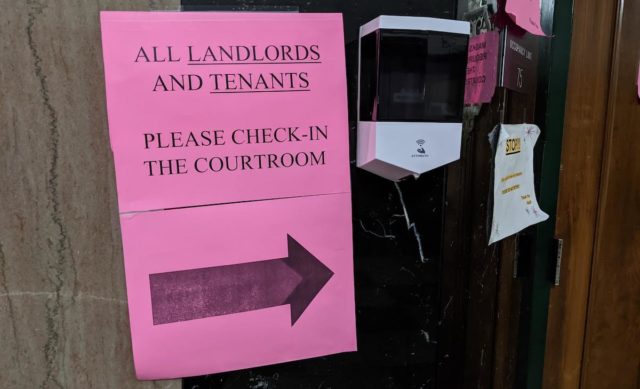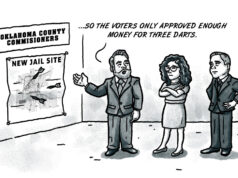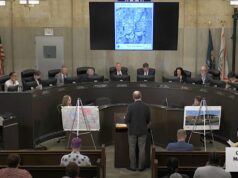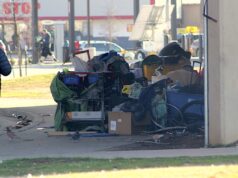

Evictions in Oklahoma County are climbing rapidly as stimulus and unemployment benefits paid directly to individuals as part of the federal government’s coronavirus response come to an end, Michael Figgins, executive director of Legal Aid Services of Oklahoma, said Tuesday.
Figgins spoke at a virtual eviction-prevention forum hosted by Oklahoma County commissioner Carrie Blumert and Oklahoma City City Council members Nikki Nice, JoBeth Hamon and James Cooper.
Legal Aid is a nonprofit organization that provides civil legal assistance to low-income people throughout Oklahoma. Figgins said the organization has been assisting those who come to the county courthouse in response to an eviction summons.
In 2020, the number of eviction filings dropped significantly, largely thanks to a combination of federal eviction moratoriums and financial assistance programs that gave money directly to individuals.
But as these programs have ended, there has been a resurgence of eviction filings. Figgins said there were 782 filings in Oklahoma County in May, 908 more in June and 995 in July. Last month, there were 1,064 filings, he said.
According to data given to NonDoc by County Court Clerk Rick Warren in September 2020, the current numbers are near pre-pandemic levels. In 2019, approximately 1,197 evictions were filed on average each month, for a total of 14,360 during the year.
“There is a pattern there,” Figgins said. “They’re getting larger every month. In August, there were over 250 eviction filings per week.”
Most who are evicted are part of marginalized groups, he said.
“From my experience as executive director of Legal Aid, I can tell you that the people who are facing eviction are primarily black and Latino,” he said. “They’re low income. They’re women with kids. They have low credit scores and they make liberal use of payday loans, pawn shops and credit cards to make ends meet. During the pandemic, when we had the stimulus and unemployment where it was, this population actually had economic gains. Now with the stimulus gone and unemployment gone as well, they have a lot more to lose and they’re falling further behind.”
But Figgins said not all of eviction filings result in people being kicked out of their homes.
“If there is such a thing as a silver lining, the number of cases dismissed, where the tenant prevailed, was 764 in August,” he said. “So far, we’ve had about 3,000 prevented (this year), because the tenant responded to the summons and came to the courthouse and got assistance.”
Evictions can lead to homelessness
The Homeless Alliance is a non-profit organization that works to reduce homelessness in Oklahoma City. Executive director Dan Straughan said the current shelter bed availability is far short of what is needed.
“Our nose count of people experiencing homelessness in Oklahoma City tonight will be over 1,500, so there are still 700 people unsheltered in the community,” Straughan said.
Straughan said escalations in the number of evictions aggravate an existing problem.
“Michael (Figgins) is talking about 1,000 evictions filed in Oklahoma County last month,” Straughan said. “Those are households. Imagine three people per household. That’s 3000 people in a system that’s is almost 100 percent over capacity today. Preventing evictions becomes key.”
Straughan said the Homeless Alliance helped put 13,500 people into homes last year. But, even though the agency has become much more adept at finding housing for people in recent years, there is a huge demand for housing in Oklahoma City.
“Across the whole system of housing providers in the social services system each year for the last three years, we’ve moved more people into housing than ever before,” he said. “That said, even though we’re getting better and better at re-housing people, our one-night census numbers have continued to climb. That means, despite getting better at putting people into housing, system inflow is swamping that. The only way to get numbers down is to choke off that inflow.”
More housing a solution
According to the 2020 census, about 14.9 percent of Oklahoma City’s population lives in poverty. An individual making $9,000 or less per year is considered to be below the poverty line. That number is $26,200 for a family of four, Straughan said.
The long term solution is more affordable housing, he said. The Oklahoma Housing Finance Agency estimated in 2014 the city is short about 4,500 units of affordable housing units.
“In the long term that shortage of truly affordable housing is what’s driving our homeless numbers,” Straughan said. “More than mental illness. More than substance abuse. More than domestic violence. More than anything people think of when they think of what causes homelessness. It’s the lack of affordable housing. Preventing evictions on the front end, while making landlords whole, is going to be the key for the broader community to reduce our homeless population.”
Follow @NonDocMedia on:
‘There’s a lot of money out there’
Community Cares Partners is a public-private partnership that provides emergency rental assistance funds allocated by the state and municipalities to help maintain housing stability for both renters and landlords.
The organization serves all 77 counties in the state, and the funds it uses came from federal CARES Act money distributed to state and local governments in response to the coronavirus pandemic.
So far, Community Cares Partners has distributed $56.4 million in assistance to tenants facing eviction, or to landlords to replace income from tenants who are unable to pay their rent. All told, it has provided about 13,525 households with assistance, according to its website.
Executive director Ginny Bass Carl said getting landlord participation in the program has been a hurdle.
“We should have marketed this from the beginning as landlord assistance, because that’s been the biggest challenge,” she said. “As a landlord, and as someone who likes money in my bank, I don’t understand not taking money, but there are some, for whatever reason, and there are a variety of reasons, they’re a hard no. Others we’ve convinced and they’ve gotten onboard. As many evictions as we’re able to prevent because of paying assistance, there’s still a lot that go through, especially as they sue for possession rather than failure to pay.”
Carl said the best thing those facing eviction can do is to stay involved in the process. Ignoring summons and correspondence from the county and your landlord is a mistake, she said.
“If someone has an eviction filed against them, we can get you assistance,” she said. “I tell people, if you want to be evicted just don’t go to court. That’s the clearest, cleanest way to get evicted. Show up to court and then Legal Aid can help you file an application with us for assistance.”
Carl said that the Community Cares Partner’s application portal is currently closed until Oct. 14 to clear a backlog, but the organization can still get assistance to those in imminent need and will be able to process more applications when its backlog is processed. Almost 95 percent of those who apply for assistance get it, she said.
“It’s a pretty low threshold to help you,” she said. “There’s a lot of money out there. We’re at the court house every day in Cleveland and Oklahoma County. We work as well as we can with landlord attorneys and landlords to get the money into the hands of landlords. In the event a landlord chooses not to work with us and accept assistance, we pay the tenant directly. The goal is to keep people in housing.”
Carl said assistance for arrears rent as far back as March 2021 can also be paid by the agency, if necessary.
“If you are evicted and need to move, it’s really hard to move with that debt on your record,” she said.
Where to find help
For those facing eviction, assistance can be found at the Homeless Alliance, (405) 415-8410; Legal Aid of Oklahoma, (888) 534-5243; and Community Cares Partners via online submission form.




















